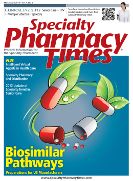Publication
Article
Specialty Pharmacy Times
2013 Specialty Trend in Senior Care
Despite the challenges faced when treating patients in a senior care setting, specialty drug trend in this population continues to increase. Providing quality, accessible specialty pharmacy services to facilities that care for these patients is of utmost importance as the population in the United States ages and additional complexity is added.
Editor’s Note: This is an update to the article, “Specialty Trend on the Rise in Senior Care: A Focus on Long Term Care,” which was published in the April 2012 edition of Specialty Pharmacy Times.1 Please visit www.specialtypharmacytimes.com to read that article, which focused on defining senior care and long-term care (LTC), discussing why the specialty drug trend is increasing among the senior care population, and important considerations such as regulatory and personnel factors that need to be taken into account when dispensing specialty medications to patients residing in LTC facilities.
Despite the challenges faced when treating patients in a senior care setting, specialty drug trend in this population continues to increase. Providing quality, accessible specialty pharmacy services to facilities that care for these patients is of utmost importance as the population in the United States ages and additional complexity is added.
Specialty drug trend is not only increasing in the community setting, but also among those pharmacies that service the patients who live in senior care settings such as Long Term Care (LTC) facilities. This article will provide an update to the specialty trend in senior care and will discuss key factors impacting specialty in senior care over the last year. For the third straight year, the 2013 Managed Health Care Associates (MHA) Independent Long Term Care Member Study included a section on specialty, which consisted of an analysis of LTC pharmacy dispensing data as well as a pharmacist survey component.2
DATA ANALYSIS
The data analysis was based on 1010 closed-door LTC pharmacies that encompassed 2.7 million individual patient profiles. The 2013 MHA Independent LTC Member Study showed a third consecutive year of growth in prescription count among specialty categories within LTC pharmacies. This includes a 5% increase in the utilization of oral oncology medications, an 8% growth in the use of medications to treat multiple sclerosis (MS), a 14% increase in the use of injectable osteoporosis medications, a 15% increase in the use of medications to treat HIV, and a 27% increase in biologics used to treat inflammatory conditions (Figure 1).
MS therapies within LTC demonstrated an 8% growth for the 2013 study period with Copaxone, Avonex, Betaseron, Rebif, Extavia, and Gilenya posting sustained or increased growth in prescription count from 2011 to 2012. Growth in the MS therapeutic category has remained strong since it was first studied in this patient population in 20113,4 (Figure 2).
Biologics for inflammatory conditions also posted significant growth in the 2013 LTC study and are used to treat rheumatoid arthritis, ankylosing spondylitis, Crohn’s disease, ulcerative colitis, psoriasis, and psoriatic arthritis. Overall growth of the biologics for inflammatory conditions therapeutic category has remained extremely strong for the past 3 years of the MHA Independent LTC Study 3,4 (Figure 4).
The study also sought to better understand the physician specialties prescribing specialty medications in the LTC setting. Prescribing of medications for inflammatory conditions, MS, and oral oncology was primarily driven by health care professionals within family and internal medicine. This is reflective of current prescriber dynamics within LTC.
SURVEY RESULTS
The survey component of the 2013 MHA Independent LTC Study examined pharmacy trends within various types of senior care settings, looked at specialty services offered by LTC pharmacies, reviewed the impact of limited distribution medications, and explored whether or not Risk Evaluation and Mitigation Strategies (REMS) requirements are affecting LTC pharmacies.
THERAPEUTIC CATEGORIES BY RESIDENT SETTING
The respondents in the 2013 MHA Independent LTC Study showed a trend toward increased dispensing of specialty therapeutic categories in the skilled nursing resident setting. Although dispensing of specialty therapeutic categories into assisted living facilities remained steady, double-digit increases of dispensing into skilled nursing facilities was seen in the inflammatory conditions, MS, injectable osteoporosis, oral oncology, and HIV therapeutic categories (Figure 3).
SPECIALTY SERVICES
Specialty services continue to be directly provided to patients by LTC pharmacies across various senior care residence settings. Patient education services, drug information, and drug administration education focused on specialty therapeutic categories was provided by 37% of survey respondents. Therapeutic management protocols and programs for specialty therapies are in place in the practices of 28% of respondents. Thirty-four percent of respondents provide other specialty services such as a system to capture non-claims level data (such as clinical and disease state metrics) for specialty reporting purposes, a sales team focused on specifically growing specialty volume, or dedicated specialty reimbursement services.
LIMITED DISTRIBUTION
A significant challenge that is faced in providing specialty drugs to residents of senior care facilities is limited distribution. It is common business practice within the LTC industry that 1 pharmacy services the entire LTC facility resident census. LTC pharmacies have the expertise and understanding of the regulations and nuances that accompany servicing nursing home patients. If the LTC dispensing pharmacy is not given access to the specialty drug needed to fulfill an order, significant barriers are created to get that resident the specialty medication in a timely manner while also meeting all the regulations that are set forth by the federal government. In addition, this creates fragmented and possibly a complete lapse in care that not only impacts the resident but that is also challenging for the LTC interdisciplinary team to manage.
For the first time, the 2013 MHA Independent LTC Study attempted to quantify the impact of limited distribution medications on pharmacies that provide services to long-term care residents. A total of 73% of respondents reported inability to fill at least 1 prescription in the month preceding the survey due to limited distribution practices imposed by the FDA or manufacturer (Figure 5).
The most common reported response to encountering a limited distribution product is that the prescriber will change the prescription order to a medication that is available to be filled and dispensed by the facility’s current long-term care pharmacy provider.
MHA Independent Long Term Care Study 2013 based on survey results of 122 respondents.
REMS
Also new in the survey for 2013 were a number of questions designed to better understand how REMS requirements impact long-term care pharmacies. A total of 41% of the respondents find REMS requirements to be burdensome in the pharmacy practice and 11% of responding pharmacies reported the need to add pharmacy staff to deal with increasing REMS requirements.
The survey attempted to dig deeper into which components of REMS respondents find most burdensome to their practice. Of those who find REMS requirements burdensome, 70% find all components of the REMS to be difficult to manage (ie, knowing which medications carry REMS requirements, medication guide distribution, pharmacy training/certification requirements, and prescriber training/ certification requirements). A total of 16% of the respondents stated that knowing which medications they dispense that carry a REMS requirement is the most difficult part of managing a REMS.
ADDITIONAL FACTORS IMPACTING SPECIALTY IN LTC SETTINGS
One of the biggest changes in the LTC setting was the implementation of short-cycle dispensing, which was effective January 1, 2013.5 The Centers for Medicare & Medicaid Services (CMS) required all pharmacies dispensing prescription drugs to long-term care facilities—including skilled nursing facilities and nursing homes—and billing Part D Plans and Medicare Advantage plans to dispense solid oral dosage forms of brand name drugs in no greater than 14-day increments.
Oral branded specialty drugs are subject to the provision, as the only oral dosage form exceptions are antibiotics that are for short-term treatment of an acute infection and drugs that are dispensed in their original container as indicated in the FDA Prescribing Information. Although the requirement does not apply to non-solid oral brandname drugs, such as liquids, inhalers, and topicals, the dispensing of oral branded specialty drugs has been impacted by this change.
Despite the challenges faced when treating patients in a senior care setting, specialty drug trend in this population continues to increase. Providing quality, accessible specialty pharmacy services to facilities that care for these patients is of utmost importance as the population in the United States ages and additional complexity is added.
References
- Specialty trend on the rise in senior care: a focus on long term care. Specialty Pharmacy Times, April 2012. www.specialtypharmacytimes.com/publications/specialty-pharmacy-times/2012/april-2012/Specialty-Trend-on-the-Rise-in-Senior-Care-A-Focus-on-Long-Term-Care. Accessed February 22, 2013.
- MHA Independent Long Term Care Member Study, 2013. Managed Healthcare Associates, Inc, 2013. Available upon request at [email protected]
- MHA Independent Long Term Care Member Study, 2011. Managed Healthcare Associates, Inc, 2011. Available upon request at [email protected]
- MHA Independent Long Term Care Member Study, 2012. Managed Healthcare Associates, Inc, 2012. Available upon request at [email protected]
- NCPA overview of short cycle dispensing in long term care. National Community Pharmacists Association. www.ncpaltc.org/pdfs/Overview-of-Short-Cycle-Dispensing-for-LTC-June2012.pdf. Published December 2012. Accessed March 6, 2013.
About the Authors
Kimberly Binaso, PharmD, RPh, CCP, FASCP, CGP, FASHP, is the executive director of clinical services for Managed Healthcare Associates, a health care services organization located in Florham Park, New Jersey. Dr. Binaso is a certified consultant pharmacist in the state of New Jersey (CCP), fellow of both the American Society of Consultant Pharmacists (FASCP) and the American Society of Health Systems Pharmacists (FASHP), and a board-certified geriatric pharmacist (CGP). She is an active member of the American Society of Consultant Pharmacists, the American Society of Health Systems Pharmacists, and the American Medical Directors Association. Dr. Binaso serves as a national visiting professor and senior care expert presenter, contributing posters and articles on a variety of geriatric clinical issues.Stacey Ness, PharmD, RPh, MSCS, AAHIVP, has worked in both national specialty pharmacy and payer organizations and has experience in clinical management, adherence, and persistency programs, as well as chronic disease cost optimization strategies. Dr. Ness is active in the Consortium of Multiple Sclerosis Centers, Academy of Managed Care Pharmacy, National Home Infusion Association, National Association of Specialty Pharmacy, Specialty Pharmacy Certification Board, and Hematology and Oncology Pharmacy Association, and has served on the Minnesota Medicaid Drug Formulary Committee since 2008. She is a multiple sclerosis certified specialist, a credentialed HIV pharmacist, and currently serves as the director of specialty clinical services at Managed Health Care Associates, Inc, a health care services organization based in Florham Park, New Jersey.







